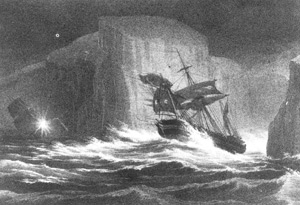
| Glasgow Digital Library | Voyage of the Scotia | BRUCE | PEOPLE | SHIP | ANTARCTIC | INDEX |
|---|
Several Antarctic ships had narrow escapes navigating in the ice and some were lost - hardly surprising given the ice-cold and iceberg-filled waters, the gale-force winds and the long dark nights. On one terrible dark night Erebus was negotiating an iceberg when it noticed Terror was about to run her down.
'We instantly hove all aback to diminish the violence of the shock; but the concussion when she struck us, was such as to throw almost every one off their feet; our bowsprit, fore-topmast and other smaller spars, were carried away: and the two ships were hanging together, entangled by their rigging, and dashing against each other with fearful violence, we were falling down upon the lofty berg under our lee, against which the waves were breaking and foaming to near the summit of the perpendicular cliffs. Sometime she rose high above us, almost exposing her keel to view, and again descended as we in our turn rose to the top of the wave, threatening to bury her beneath us, whilst the crashing of the breaking upper works and boats increased the horror of the scene. Providentially they gradually forged past each other, and separated before we drifted down amongst the foaming breakers, and we had the gratification of seeing her clear the end of the berg, and of feeling that she was safe.

But she left us completely disabled; the wreck of the spars so encumbered the lower yards, that we were unable to make sail, so as to get headway on the ship; nor had we room to wear round, being by this time so close to the berg that the waves, when they struck against it, threw back their sprays into the ship. The only way left to us to extricate ourselves from this awful situation was by resorting to the hazardous expedient of a stern-board, which nothing could justify during such a gale and with so high a sea running, but to avert the danger whilst every moment threatened us of being dashed to pieces. The heavy rolling of the vessel, and the probability of the masts giving way each time the lower yard-arms struck against the cliffs, which were towering high above our mastheads, rendered it a service of extreme danger to loose the mainsail; but no sooner had the order been given, than the daring spirit of British seamen manifested itself - the men ran up the rigging with great alacrity as on any other occasion and although more than one was driven off the yard, they after a short time succeeded in loosing the sail.
'Amidst the roar of the wind and the sea it was difficult both to hear and to execute the orders that were given, so that it was three-quarters of an hour before we got the yards braced by, and the maintack hauled on board sharp aback - an expedient that perhaps had never before been resorted to by seamen in such weather: but it had the desired effect; the ship gathered sternway, plunging stern into the sea, washing away the gig and quarter boats, and, with her lower yard-arms scraping the rugged face of the berg, we in a few minutes reached its western termination, the undertow as it is called, or the reaction of water from its vertical cliffs, alone preventing us being driven to atoms against it.
'No sooner had we cleared than another (berg) was seen directly astern of us, against which we were running; and the difficulty now was to get the ship's head turned around and pointed fairly through between the two icebergs, the breadth of the intervening space not exceeding three times her own breadth; this , however, we happily accomplished and in a few minutes, after getting the wind, she dashed through the narrow channel between the two perpendicular walls of ice, and the foaming breakers which stretched across it, and the next minute we were in smooth water under its lee.'
James Clark Ross
| Glasgow Digital Library | Voyage of the Scotia | BRUCE | PEOPLE | SHIP | ANTARCTIC | INDEX |
|---|